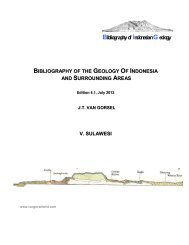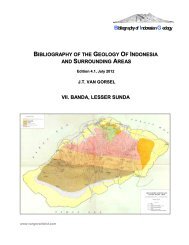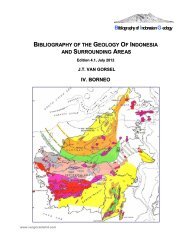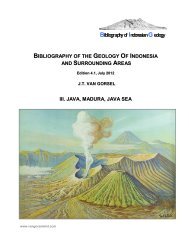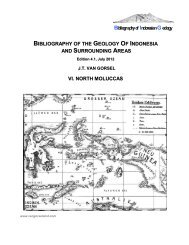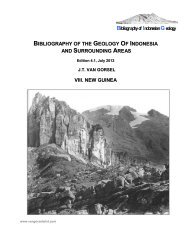Sumatra, Sunda Shelf, Natuna - Bibliography of Indonesia Geology
Sumatra, Sunda Shelf, Natuna - Bibliography of Indonesia Geology
Sumatra, Sunda Shelf, Natuna - Bibliography of Indonesia Geology
You also want an ePaper? Increase the reach of your titles
YUMPU automatically turns print PDFs into web optimized ePapers that Google loves.
elatively small, 1-2 km in Cumi-Cumi PSC. Magnitude <strong>of</strong> graben inversion depends on initial size and<br />
orientation <strong>of</strong> original half graben. Each graben unique inversion history in framework <strong>of</strong> Miocene inversion)<br />
Grabowski, G.J., R.M. Kick & D.A. Yurewicz (1985)- Carbonate dissolution during late-burial diagenesis <strong>of</strong><br />
the Terumbu Limestone (Miocene), East <strong>Natuna</strong> Basin, South China Sea, <strong>Indonesia</strong>. AAPG Bull. 69, 2, p. 258<br />
(Abstract only. Terumbu Lst reservoir 200 TCF (72% CO2), 1500 m <strong>of</strong> M-L Miocene platform-reef carbonates<br />
with complex diagenetic history. Partial marine cementation and micritization in platform environments during<br />
deposition. Freshwater diagenesis below subaerial unconformities within and at top Terumbu. Aragonitic<br />
grains leached, pores partially cemented by low-Mg calcite. Pressure solution and cementation during burial to<br />
~3,000m left minor porosity. Late burial leaching high-Mg calcite. Ferroan-calcite and dolomite cements line<br />
pores and fluorite crystals occlude many pores. Whole-rock isotopes suggest high-T carbonate alteration. CO2<br />
derived from dissolved Terumbu Lst. Fluoride-bearing hydrothermal fluids from granitic basement selectively<br />
dissolved constituents in deeply buried Terumbu)<br />
Gunarto, M.O., B.P. Istadi & H.R. Siregar (2000)- Sequence stratigraphy study in Northwest <strong>Natuna</strong>. Proc. 29 th<br />
Ann. Conv. Indon. Assoc. Geol. (IAGI), Bandung, 1, p. 103-139.<br />
(11 sequences in Late Eocene- M Miocene between basement and base Muda unconformity (M-L Miocene<br />
boundary. Geological history <strong>Natuna</strong> basin 4 phases: syn-rift (seq. 1-2; Late Eocene- E Oligocene), post-rift<br />
(seq. 3-4; Late Oligocene), syn-inversion (seq. 5-10; E-M Miocene), post-inversion (Late Miocene- Recent)<br />
Haile, N.S. (1970)- Radiocarbon dates <strong>of</strong> Holocene emergence and submergence in the Tambelan and Banguran<br />
Islands, <strong>Indonesia</strong>. Geol. Survey Malaysia Bull. 3, p. 135-137.<br />
(C14 dates from <strong>Natuna</strong> islands suggest sea level was higher by at least 0.3m at ~5600 BP and 0.4m at ~5270<br />
BP. Wood from peat below tide level indicates sea level 0.7m lower at ~6260 BP)<br />
Haile, N.S. (1970)- Notes on the geology <strong>of</strong> Tambelan, Anambas and Bunguran (<strong>Natuna</strong>) islands, <strong>Sunda</strong> shelf,<br />
including radiometric age determinations. United Nations ECAFE, CCOP Techn. Bull. 3, p. 55-90.<br />
(Tambelan Islands S <strong>of</strong> <strong>Natuna</strong> composed <strong>of</strong> basic-intermediate igneous rocks and tuffs, intruded by Late<br />
Cretaceous (84 Ma) granite. Anambas Islands, SW <strong>of</strong> <strong>Natuna</strong>, composed <strong>of</strong> granite, andesite, etc. Bunguran-<br />
<strong>Natuna</strong> Islands composed <strong>of</strong> probably Mesozoic folded cherts and metasediments, with three granite intrusions,<br />
one dated as 73 Ma. Unconformably overlain by flat-lying Tertiary <strong>Natuna</strong> sandstone)<br />
Haile, N.S. (1971)- Late Cretaceous age based on K/Ar dates <strong>of</strong> granitic rock from the Tambelan and Bunguran<br />
Islands, <strong>Sunda</strong> <strong>Shelf</strong>, <strong>Indonesia</strong>. Geol. Mijnbouw 50, 5, p. 687-690.<br />
Haile, N.S. (1971)- Confirmation <strong>of</strong> the Late Cretaceous age for granite from the Bunguran and Anambas<br />
islands, <strong>Sunda</strong> shelf, <strong>Indonesia</strong>. Geol. Soc. Malaysia Newsl. 30, p. 6-8.<br />
(Late Cretaceous radiometric ages for granites from <strong>Natuna</strong>- Anambas islands)<br />
Hakim, A.S. (2004)- The occurrence <strong>of</strong> the dismembered ophiolite in the Bunguran islands, Riau Province,<br />
<strong>Sumatra</strong>. J. Sumber Daya Geol. 14, 3, p. 1-<br />
Hakim, M.R., M.Y.Y. Naiola, Y.R.A. Simangunsong, K.P. Laya & T.Y.W. Muda (2008)- Hydrocarbon play <strong>of</strong><br />
West <strong>Natuna</strong> basin and challenge for new exploration related to structural setting and stratigraphic succession.<br />
Proc. 32 nd Ann. Conv. Indon. Petrol. Assoc., IPA08-SG-039, 11 p.<br />
(W <strong>Natuna</strong> Basin started to form in Late Eocene by SW-NE trending half-graben rifting within <strong>Sunda</strong> Platform.<br />
M Oligocene- E Miocene tectonic quiescence followed by M Miocene tectonic inversion. Significant inversion<br />
in N part <strong>of</strong> basin, none in main area. Eo-Oligocene lacustrine source rocks. Primary reservoir M-L Oligocene<br />
Gabus Sst. Still remaining hydrocarbon potential.<br />
Hakim, A.S. & N. Suryono (1994)- Geological map <strong>of</strong> the Teluk Butun and Ranai Sheet, Sumatera. Geol. Res.<br />
Dev. Centre, Bandung.<br />
(Includes <strong>Natuna</strong> Islands surface geology. Mainly E-M Cretacoeus Bunguran Fm melange sediments and Late<br />
Cretaceous granites)<br />
<strong>Bibliography</strong> <strong>of</strong> <strong>Indonesia</strong> <strong>Geology</strong> v. 4.1 146 www.vangorselslist.com July 2012



